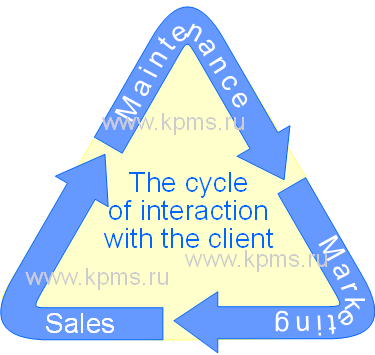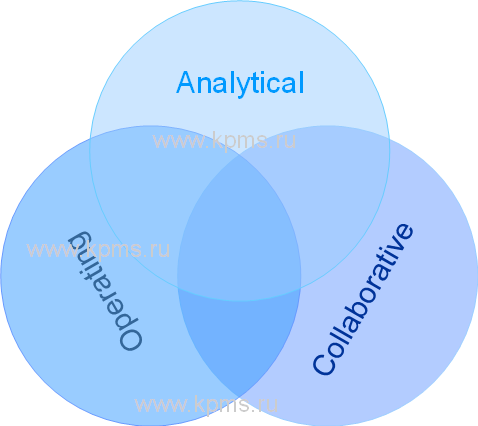CRM (customer relationship management) systems are a class of automation systems that allow you to manage interaction with customers. They include all aspects of interaction: from various business contacts, to sales, and customer service requests. The main purpose of using a CRM system is to manage and systematize information about the client. This makes it possible to understand the behavior of customers and organize more effective communication whit them.
CRM systems
Automation of customer interaction processes provides significant assistance and simplifies the implementation of the requirements of the ISO 9001 standard. The quality system requires that all issues related to the interaction between the organization and its customers (consumers) are managed. Such issues include: actions to identify needs, determine consumer requirements, provide information about the status of orders, receive feedback from consumers, etc. As a rule, such information is stored and processed separately. CRM systems allow you to combine information from different sources in one system.
CRM system structure
The process of interaction with customers includes many tasks: identification of target consumers, sales management, optimization of information exchange, improvement of customer relations, identification of customer needs, feedback analysis, etc.
Most of these tasks can be structured into groups. Groups form the basic processes of the cycle of interaction with consumers (customers). The structure of existing CRM systems is aimed at maintaining each of the stages of this cycle.

In general, the cycle includes:
- marketing;
- sales;
- service.
The basic needs of an organization for managing customer interaction can be realize through the groups of tasks that CRM systems solve.
These groups include:
- sales management. A group of tasks related to sales management allows you to automate the execution of orders. This element of the CRM system is responsible for the customer receives his order with the required quality and at the set time. In addition, it can be used to track all customer requests, create the necessary documents accompanying sales, and plan subsequent actions of customer service personnel.
- marketing management. This element of the CRM system is necessary for automating and supporting customer service, developing customer relationships, conducting surveys and market research, analyzing the information received, registering potential customers, identifying their needs, and drawing up marketing plans.
- relationship management. This element is necessary for collecting and managing general information about consumers and customers. Such information includes contact information, the name of the company (client), his profile, request history, events, business relations, feedback, etc.
- maintain management. This element of the CRM system provides planning of delivery of products and services to the consumer, receiving feedback, claims and customer requests for maintenance.
- analysis and reporting. This group of tasks includes all tasks related to obtaining information about the effectiveness of working with clients and the business as a whole. This element of the CRM system allows you to analyze information about working with clients in various areas. The results of the analysis and reporting can be used to make strategic decisions.
- integration. The effectiveness of a CRM system depends on the exchange of information between its elements and with external systems. The CRM system structure should include elements that allow internal and external integration.
Each of these elements must work consistently and provide processing, storage, feedback and management of all information on the process of customer relationship.
CRM system Types
Modern CRM systems can be divided into several types. The types of CRM systems are allocated depending on the tasks to be solved and the stages of the cycle of interaction with consumers, which these systems are aimed at supporting.
There are three main types of systems:

- operating systems. This type of CRM systems allows you to automate operational activities. Operational CRM systems process various data sets "tied" to each specific client. They are necessary for operational support of sales, marketing, and customer service departments (service support). As a rule, the data sets that operational CRM systems work with include all contact information about the client, the history of interaction, types, volume and number of purchases, channels of communication with the client, etc. The information from these systems is basic for the operation of analytical CRM systems.
- analytical systems. This type of systems is necessary to support at the strategic level the stages of marketing and sales. They allow you to plan marketing companies and choose the most effective sales strategies. Analytical CRM systems process information from various databases, systematize information, and identify the most effective trends in customer interaction based on certain algorithms.
- collaborative systems. This type of CRM system provides collaboration with customers, i.e. customers have the opportunity to interact directly with the company's CRM system. Interactions can be carried out through web pages, e-mail, automatic voice communication, etc.
These types of systems are basic. CRM system manufacturers offer combinations of these three types.
Advantages of the CRM system
The main application of the CRM system is related to the organization and management of customer relationships. First of all, the advantages of the CRM system are manifested in an increase in sales indicators, in particular, the volume of sales increases, their efficiency increases, and the cost of customers attracting is decreased. CRM systems have a significant impact on the manageability and work culture of the organization.
The main advantages of the CRM system include:
- increasing the speed of decision-making. The data processing and analysis process is accelerated by combining disparate customer data. As a result, personnel that are responsible for customer relationship can see the entire history of contacts, respond to requests more quickly and make decisions on them.
- improving the efficiency of the use of working time. CRM systems allow you to automatically track important events related to customers and issue notifications. There is no need to search this information in disparate sources.
- improving the effectiveness of marketing activities. Marketing campaigns become more customer-oriented because CRM systems store all information about the client and the history of interaction. The company has the opportunity to organize marketing events aimed at each specific client.
- improving the reliability of reports. Systematization of information increases the reliability of reports and the accuracy of sales forecasts.
- determining the value of each client. Allows an organization to identify and plan resource needs for working with a particular client. CRM systems allow you to set the priority of attracting resources depending on the value of the client.
- reduction of paper document flow. All documents can be converted into electronic form by automating the process of interaction with the client.
- reduction of customer leaves. The staff has access to all the details of interaction with the client due to the use of the CRM system. This improves the quality and efficiency of customer service.
- elimination of tasks duplication. CRM systems can be integrated with other management systems, which eliminate the double work of data transmission and processing.
- process ordering. CRM systems allow you to combine all customer interaction processes into a single system. Process inputs and outputs become available for different processes, which simplifies the management of contracts, projects, events, products, etc., which are associated with each specific client.
- improving the management culture. Automation of the process reduces the dependence of the tasks being solved on the subjective actions of employees. CRM systems set uniform rules for working and interacting with customers.
- protection and safety of data. It is possible to organize centralized management of access to customer data and ensure their safety through the use of a CRM system.
Criteria for choosing a CRM system
There are a large number of offers for CRM systems on the market of software products and information systems. These systems are various in terms of the volume of tasks to be solved, the equipment used, and work technologies. Many factors must be taken into account when choosing a CRM system.
It is important to consider the following for the purposes related to the work of the quality system:
- compliance with business requirements. It is necessary to exactly determine what tasks it will solve in the conditions of a particular enterprise before making a decision on the implementation of a CRM system. The system must be chosen according to the requirements of the business, and not vice versa.
- ease of use. The user interface should be as simple and user-friendly as possible. If a CRM system complicates the process of interacting with customers and increases the number of actions that employees will need to work, then such a system will remain unclaimed. This will lead to the fact that the key element of the quality system - data registration - will not be implemented.
- availability of analytical tools. The CRM system should make it possible to conduct an analysis focused on each specific customer in order to analyze and identify consumer behavior, their requirements and expectations.
- the ability to configure processes. It is important that the CRM system allows you to flexibly change settings depending on the progress of the process. This possibility allows you to more fully define and automate each specific process.
- scalability. This criterion is especially important for large organizations. It is necessary that the solutions used in the CRM system are scalable and can be applied to a large number of users.
- customization for the conditions of a specific industry. Each industry and scope of activity has its own specifics of working with clients. This specificity should be taken into account in the CRM system.
- customizing for users. The organization itself and the environment surrounding it change over time. This leads to the need to change the working conditions of CRM system users. It is necessary that the system provides for the possibility of simple and quick changes in user functions in accordance with changing business tasks.
- integration with other information systems. There may be other automation and process management systems in the organization, so an important selection criterion is the possibility of integration and data exchange between the CRM system and other automation systems.
- cost of ownership. The cost of owning a CRM system consists of several components: the cost of licenses, integration of hardware and software, ongoing maintenance costs and administrative costs for managing IT assets. This criterion is also essential when choosing a system.
- efficiency of technical support. An important factor is the speed of the system provider's response to user requests and the solution of their problems.
There are a number of other criteria that need to be taken into account when choosing a CRM system. The above criteria are the most general and necessary for most companies.
CRM system implementation
The implementation of a CRM system takes the organization to a new level of work and customer service quality. Many factors must be taken into account for effective and successful implementation. The implementation process always affects the organization's customers, so it is important to clearly define the needs of the company (what tasks the CRM system should solve) and plan the entire process in detail.
The management of the organization must take a number of steps for the successful implementation of the CRM system.
The main steps that ensure the successful implementation of a CRM system include:
1. Involvement of key stakeholders.
Before starting the project, it is necessary to identify all stakeholders (users, customers, management, suppliers, etc.) and assess their expectations from the implementation of the CRM system.
Many CRM projects fail because stakeholders are not involved in the implementation process. They should take part in assessing business objectives, developing an implementation strategy, and determining the rules for using CRM in the company. The top management should provide financial and time resources for the implementation of the CRM system.
Also, it is necessary to determine who will benefit from the CRM system, for example: customers, staff, suppliers, business partners, etc.
2. Definition of CRM strategy.
Defining a CRM strategy involves identifying critical interactions between business goals, business processes, people, and software. A CRM strategy is needed to improve these interactions. It is necessary to determine the benefits of the implementation and establish key performance indicators before proceeding with the implementation of the software.
3. Definition of CRM implementation goals and prioritization.
You need to clearly formulate the implementation goals before starting a project to implement a CRM system. At the same time, it is necessary to take into account social and organizational factors, such as the structure of the company, roles and subordination, resistance to change.
The priority in achieving the goals should be set in such a way that the key areas of interaction with customers are affected.
4. Development of an implementation plan.
An implementation plan is drawn up after defining the strategy and objectives of the CRM system implementation. It can consist of several plans related to priorities in achieving goals. The plan should contain responsible persons, key indicators and deadlines.
5. Integration of existing systems.
The implementation plan should include a plan for the integration of existing systems with the CRM system if the organization uses information systems related to the automation of other processes.
6. Identification of CRM system suppliers.
It is necessary to compare business needs (business tasks) with the capabilities of CRM systems on the market in order to select CRM system providers. The next step in selecting suppliers will be to compare the implementation strategy and implementation and integration plans with the suppliers' proposals. It is necessary to form a list of potential suppliers of the CRM system based on these comparisons.
7. Selection of suppliers.
CRM system is a complex software product. It is necessary to take into account a number of factors related to the technical support and maintenance of the CRM system when choosing a supplier.
8. Informing stakeholders.
The implementation of a CRM system changes the order and rules for the execution of existing processes of interaction with consumers. It is necessary to inform stakeholders about the rules of operation for the effective functioning of the system. The personnel of the organization (users) of the system should be trained to work with the system, customers, suppliers, partners, should be informed about new working rules and changes related to the implementation of the CRM system.
